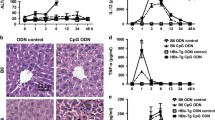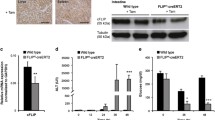Abstract
There is increasing evidence that the active contribution of hepatocytes to liver disease is strongly dependent on local cytokine environment. It has been shown in vitro that TNFα can enhance hepatocyte FasLigand (FasL)-mediated cytotoxicity. Here, we demonstrate that TNFα-induced apoptosis was associated with Fas and FasL upregulation and that a FasL-neutralizing antibody prevented TNFα-induced apoptosis. We further examined in vivo the relevance of the Fas/FasL pathway to hepatocellular apoptosis in a TNFα-driven model of acute liver failure. Livers of galactosamine/lipopolysaccharide (Gal/LPS)-exposed Fas wild-type mice highly expressed both Fas and FasL and revealed marked hepatocellular apoptosis that was almost completely blocked by soluble TNFα-receptor; this was also almost absent in Gal/LPS-exposed Fas lymphoproliferation mutant mice. Our data provide evidence for a direct link between TNFα and Fas/FasL in mediating hepatocyte apoptosis. Fratricidal death by Fas–FasL interactions of neighbouring hepatocytes may actively contribute to acute liver failure.










Similar content being viewed by others
References
Khashab M, Tector AJ, Kwo PY (2007) Epidemiology of acute liver failure. Curr Gastroenterol Rep 9:66–73. doi:10.1007/s11894-008-0023-x
Schattenberg JM, Galle PR, Schuchmann M (2006) Apoptosis in liver disease. Liver Int 26:904–911. doi:10.1111/j.1478-3231.2006.01324.x
Faubion WA, Gores GJ (1999) Death receptors in liver biology and pathobiology. Hepatology 29:1–4. doi:10.1002/hep.510290101
Kondo T, Suda T, Fukuyama H et al (1997) Essential roles of the Fas ligand in the development of hepatitis. Nat Med 3:409–413. doi:10.1038/nm0497-409
Ksontini R, Colagiovanni DB, Josephs MD et al (1998) Disparate roles for TNF-alpha and Fas ligand in concanavalin A-induced hepatitis. J Immunol 160:4082–4089
Josephs MD, Bahjat FR, Fukuzuka K et al (2000) Lipopolysaccharide and d-galactosamine-induced hepatic injury is mediated by TNF-alpha and not by Fas ligand. Am J Physiol Regul Integr Comp Physiol 278:R1196–R1201
Ando K, Hiroishi K, Kaneko T et al (1997) Perforin, Fas/Fas ligand, and TNF-alpha pathways as specific and bystander killing mechanisms of hepatitis C virus-specific human CTL. J Immunol 158:5283–5291
Morikawa A, Sugiyama T, Kato Y et al (1996) Apoptotic cell death in the response of d-galactosamine-sensitized mice to lipopolysaccharide as an experimental endotoxic shock model. Infect Immun 64:734–738
Tagawa Y, Kakuta S, Iwakura Y (1998) Involvement of Fas/Fas ligand system-mediated apoptosis in the development of concanavalin A-induced hepatitis. Eur J Immunol 28:4105–4113. doi:10.1002/(SICI)1521-4141(199812)28:12<4105::AID-IMMU4105>3.0.CO;2-8
Seino K, Kayagaki N, Takeda K et al (1997) Contribution of Fas ligand to T cell-mediated hepatic injury in mice. Gastroenterology 113:1315–1322. doi:10.1053/gast.1997.v113.pm9322527
Freudenberg MA, Galanos C (1991) Tumor necrosis factor alpha mediates lethal activity of killed gram-negative and gram-positive bacteria in d-galactosamine-treated mice. Infect Immun 59:2110–2115
Guy CS, Wang J, Michalak TI (2006) Hepatocytes as cytotoxic effector cells can induce cell death by CD95 ligand-mediated pathway. Hepatology 43:1231–1240. doi:10.1002/hep.21201
Galle PR, Hofmann WJ, Walczak H et al (1995) Involvement of the CD95 (APO-1/Fas) receptor and ligand in liver damage. J Exp Med 182:1223–1230. doi:10.1084/jem.182.5.1223
Philpott NJ, Turner AJ, Scopes J et al (1996) The use of 7-amino actinomycin D in identifying apoptosis: simplicity of use and broad spectrum of application compared with other techniques. Blood 87:2244–2251
Le Minh K, Klemm K, Abshagen K et al (2007) Attenuation of inflammation and apoptosis by pre- and posttreatment of darbepoetin-alpha in acute liver failure of mice. Am J Pathol 170:1954–1963. doi:10.2353/ajpath.2007.061056
Eipel C, Kidess E, Abshagen K et al (2007) Antileukoproteinase protects against hepatic inflammation, but not apoptosis in the response of d-galactosamine-sensitized mice to lipopolysaccharide. Br J Pharmacol 151:406–413. doi:10.1038/sj.bjp.0707230
Leist M, Gantner F, Bohlinger I et al (1995) Tumor necrosis factor-induced hepatocyte apoptosis precedes liver failure in experimental murine shock models. Am J Pathol 146:1220–1234
Wooley PH, Dutcher J, Widmer MB et al (1993) Influence of a recombinant human soluble tumor necrosis factor receptor FC fusion protein on type II collagen-induced arthritis in mice. J Immunol 151:6602–6607
Schafer T, Scheuer C, Roemer K et al (2003) Inhibition of p53 protects liver tissue against endotoxin-induced apoptotic and necrotic cell death. FASEB J 17:660–667. doi:10.1096/fj.02-0774com
Galanos C, Freudenberg MA (1993) Mechanisms of endotoxin shock and endotoxin hypersensitivity. Immunobiology 187:346–356
Fecho K, Cohen PL (1998) Fas ligand (gld)- and Fas (lpr)-deficient mice do not show alterations in the extravasation or apoptosis of inflammatory neutrophils. J Leukoc Biol 64:373–383
Watanabe-Fukunaga R, Brannan CI, Copeland NG et al (1992) Lymphoproliferation disorder in mice explained by defects in Fas antigen that mediates apoptosis. Nature 356:314–317. doi:10.1038/356314a0
Adachi M, Watanabe-Fukunaga R, Nagata S (1993) Aberrant transcription caused by the insertion of an early transposable element in an intron of the Fas antigen gene of lpr mice. Proc Natl Acad Sci USA 90:1756–1760. doi:10.1073/pnas.90.5.1756
Drappa J, Brot N, Elkon KB (1993) The Fas protein is expressed at high levels on CD4+CD8+ thymocytes and activated mature lymphocytes in normal mice but not in the lupus-prone strain, MRL lpr/lpr. Proc Natl Acad Sci USA 90:10340–10344. doi:10.1073/pnas.90.21.10340
Mohler KM, Sleath PR, Fitzner JN et al (1994) Protection against a lethal dose of endotoxin by an inhibitor of tumour necrosis factor processing. Nature 370:218–220. doi:10.1038/370218a0
Lehmann V, Freudenberg MA, Galanos C (1987) Lethal toxicity of lipopolysaccharide and tumor necrosis factor in normal and d-galactosamine-treated mice. J Exp Med 165:657–663. doi:10.1084/jem.165.3.657
Tiegs G, Wolter M, Wendel A (1989) Tumor necrosis factor is a terminal mediator in galactosamine/endotoxin-induced hepatitis in mice. Biochem Pharmacol 38:627–631. doi:10.1016/0006-2952(89)90208-6
Su GL, Klein RD, Aminlari A et al (2000) Kupffer cell activation by lipopolysaccharide in rats: role for lipopolysaccharide binding protein and toll-like receptor 4. Hepatology 31:932–936. doi:10.1053/he.2000.5634
Chen LC, Gordon RE, Laskin JD et al (2007) Role of TLR-4 in liver macrophage and endothelial cell responsiveness during acute endotoxemia. Exp Mol Pathol 83:311–326. doi:10.1016/j.yexmp.007.08.015
Ma Y, Liu H, Tu-Rapp H et al (2004) Fas ligation on macrophages enhances IL-1R1-Toll-like receptor 4 signaling and promotes chronic inflammation. Nat Immunol 5:380–387. doi:10.1038/ni1054
Ogasawara J, Watanabe-Fukunaga R, Adachi M et al (1993) Lethal effect of the anti-Fas antibody in mice. Nature 364:806–809. doi:10.1038/364806a0
Guidotti LG, Ishikawa T, Hobbs MV et al (1996) Intracellular inactivation of the hepatitis B virus by cytotoxic T lymphocytes. Immunity 4:25–36. doi:10.1016/S1074-7613(00)80295-2
Strand S, Hofmann WJ, Grambihler A et al (1998) Hepatic failure and liver cell damage in acute Wilson’s disease involve CD95 (APO-1/Fas) mediated apoptosis. Nat Med 4:588–593. doi:10.1038/nm0598-588
Roskams T, Libbrecht L, Van Damme B et al (2000) Fas and Fas ligand: strong co-expression in human hepatocytes surrounding hepatocellular carcinoma; can cancer induce suicide in peritumoural cells? J Pathol 191:150–153. doi:10.1002/(SICI)1096-9896(200006)191:2<150::AID-PATH612>3.0.CO;2-I
Woo M, Hakem R, Soengas MS et al (1998) Essential contribution of caspase 3/CPP32 to apoptosis and its associated nuclear changes. Genes Dev 12:806–819. doi:10.1101/gad.12.6.806
Woo M, Hakem A, Elia AJ et al (1999) In vivo evidence that caspase-3 is required for Fas-mediated apoptosis of hepatocytes. J Immunol 163:4909–4916
Fujiwara M, Suemoto H, Muragaki Y et al (2007) Fas-mediated upregulation of vascular endothelial growth factor and monocyte chemoattractant protein-1 expression in cultured dermal fibroblasts: role in the inflammatory response. J Dermatol 34:99–109. doi:10.1111/j.1346-8138.2006.00226.x
Eipel C, Bordel R, Nickels RM et al (2004) Impact of leukocytes and platelets in mediating hepatocyte apoptosis in a rat model of systemic endotoxemia. Am J Physiol Gastrointest Liver Physiol 286:G769–G776. doi:10.1152/ajpgi.00275.2003
Acknowledgements
The authors cordially thank Berit Blendow, Doris Butzlaff, Dorothea Frenz, Maren Nerowski, and Hartmut Stein (Institute for Experimental Surgery, University of Rostock, Germany) for excellent technical assistance, and Saleh Ibrahim (Immunogenetics Group, University of Rostock) for fruitful discussions and reviewing the manuscript. This study was supported by a grant from the Deutsche Forschungsgemeinschaft, Bonn Bad-Godesberg, Germany (Vo 450/8-1).
Author information
Authors and Affiliations
Corresponding author
Rights and permissions
About this article
Cite this article
Kuhla, A., Eipel, C., Siebert, N. et al. Hepatocellular apoptosis is mediated by TNFα-dependent Fas/FasLigand cytotoxicity in a murine model of acute liver failure. Apoptosis 13, 1427–1438 (2008). https://doi.org/10.1007/s10495-008-0269-7
Published:
Issue Date:
DOI: https://doi.org/10.1007/s10495-008-0269-7




